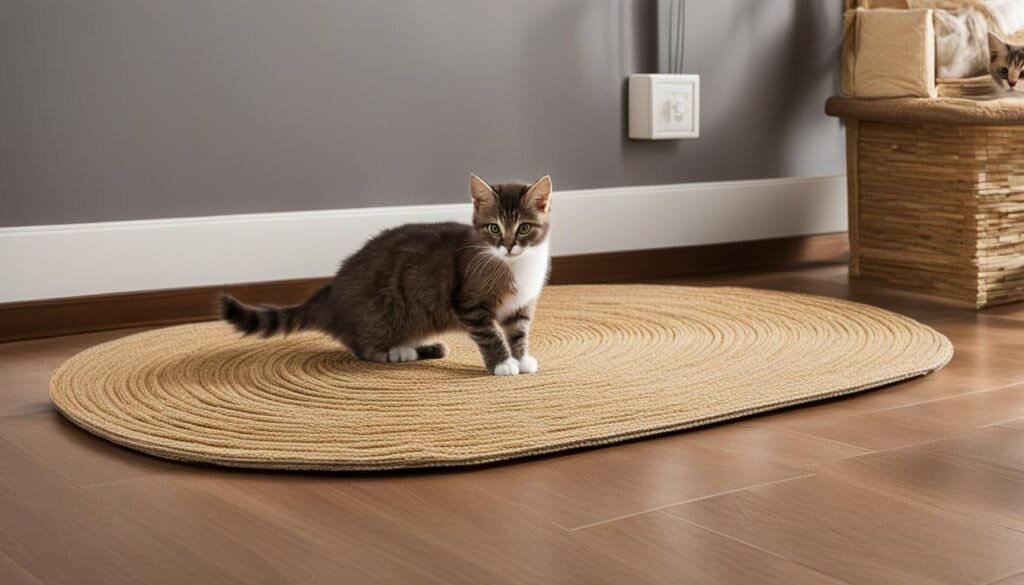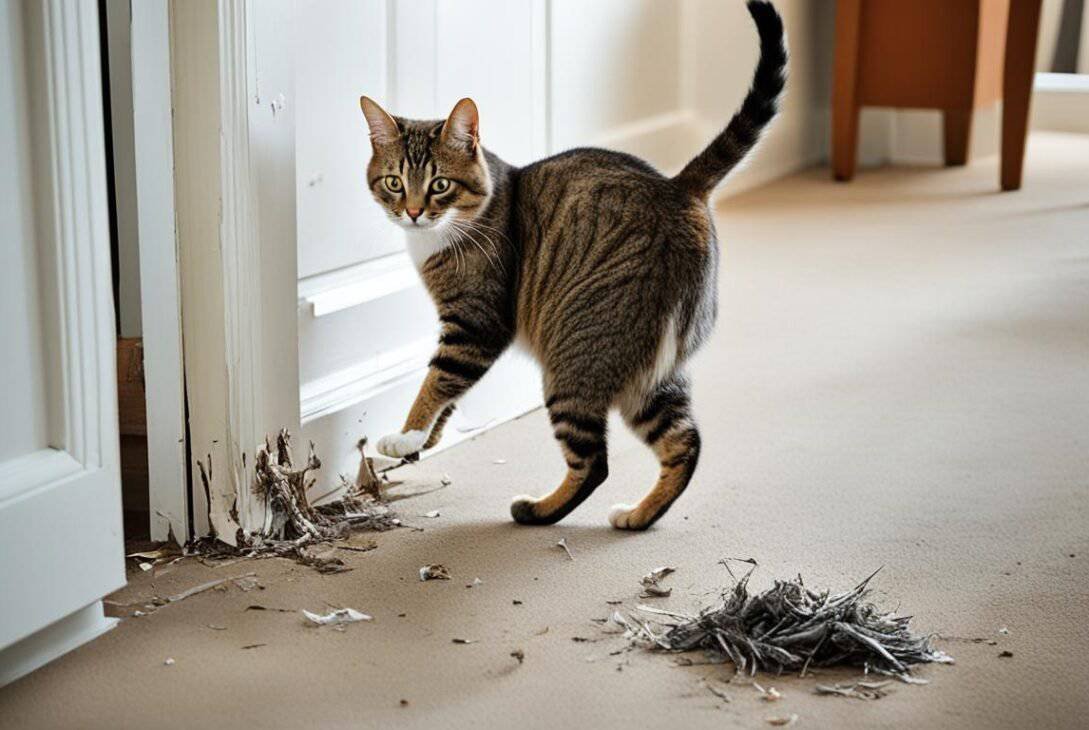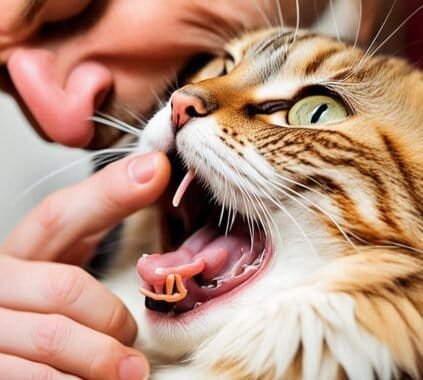Cat scratching and clawing can be a frustrating issue for pet owners, causing damage to furniture and other household items. In this article, we will discuss several natural home remedies and techniques to prevent cat scratching and clawing. These solutions are designed to redirect your cat’s behavior and protect your home while keeping your feline companion happy and healthy.
Key Takeaways
- Regularly trim your cat’s claws using specialized cat nail clippers like the Hepper Cat Nail Clipper Kit.
- Provide a suitable scratching post or scratcher made of sisal or cardboard, such as the Hepper Hi-Lo Modern Cat Scratcher.
- Use double-sided sticky tape as a deterrent on unwanted scratching areas.
- Employ sprays made from water and apple cider vinegar or citrus peels to discourage scratching and clawing.
- Protect furniture and surfaces by using aluminum foil or plastic covers.
Trim Claws Regularly
One effective way to curb cat scratching is by regularly trimming your cat’s claws. Shorter nails are less sharp and cause less damage when they scratch. You can use specialized cat nail clippers to safely trim the nails without causing pain or drawing blood. If you’re unsure how to trim the claws, you can seek guidance from a professional groomer or watch tutorials online. Consider using products like Hepper Cat Nail Clipper Kit, which provide precision clipping and ensure the safety of both you and your cat.
Keeping your cat’s claws trimmed is an important part of their overall grooming routine. Not only does it prevent damage to your furniture and other household items, but it also ensures the health and well-being of your cat. When trimming your cat’s claws, it’s essential to be gentle and patient. Here are some steps to follow:
- Find a quiet and comfortable space where you and your cat can relax.
- Hold your cat’s paw gently and extend the claw by applying slight pressure on the pad.
- Identify the translucent area called the “quick” within the claw. Be careful not to cut into it, as it can cause bleeding and discomfort.
- Using the cat nail clippers, make a quick, clean cut just below the quick. Remember to trim only the pointed tip of the claw.
- Repeat the process for each claw, taking breaks if necessary to keep your cat calm and relaxed.
Trimming your cat’s claws may take time and practice, but it’s a valuable skill that can be mastered with patience. Regular claw trimming not only helps manage scratching behavior but also promotes good hygiene in your feline companion. If you’re unsure about trimming your cat’s claws on your own, consult a professional groomer who can provide guidance and demonstrate the proper technique.
Provide a Scratching Post or Scratcher
To redirect your cat’s scratching behavior, it’s essential to provide them with a suitable alternative. A scratching post or scratcher is an ideal solution, as it allows cats to satisfy their natural need to scratch while protecting your furniture.
When choosing a scratching post, opt for one that is tall, sturdy, and made of durable materials like sisal or cardboard. These materials provide a satisfying texture for your cat’s claws and encourage them to use the post instead of your furniture.
If your cat prefers horizontal scratching, consider getting a scratcher that lies flat on the floor. This type of scratcher mimics the natural motion and orientation of scratching on the ground.
Tip: Hepper Hi-Lo Modern Cat Scratcher is a highly recommended option that offers both style and functionality, encouraging maximum engagement and exercise for your cat.
By providing a dedicated space for your cat to scratch, you can prevent them from resorting to your furniture. Remember to place the scratching post or scratcher in an easily accessible and visible area, preferably near their favorite resting spots. You can even sprinkle some catnip on the post to further entice your cat to use it.
Use Double-Sided Sticky Tape
One effective method to deter cats from scratching unwanted areas is to use double-sided sticky tape. Cats dislike the tacky texture and will avoid scratching surfaces that are covered in tape. Stick the tape onto objects or areas you want to protect, such as furniture corners or door frames. The sticky surface of the tape will discourage cats from engaging in their scratching behavior.
However, it’s important to be mindful of where you apply the tape. Avoid using it on visible areas like curtains, as it may leave residue or damage the fabric. Double-sided sticky tape is more suitable for hidden areas or objects that you don’t need to use frequently.
By using double-sided sticky tape as a scratching deterrent, you can protect your belongings while helping your cat develop more appropriate scratching habits.

Employ Sprays as Deterrents
Sprays can be an effective way to deter cats from scratching certain areas. A water spray can be used to discourage cats from scratching when caught in the act. Another option is a spray made from equal parts water and apple cider vinegar, as cats dislike the smell. Similarly, a citrus spray created by simmering lemon or orange peels in water can be effective in deterring scratching behavior. However, be cautious with essential oils, as some can be harmful to cats.
To illustrate, a simple water spray bottle can be a handy tool for redirecting your cat’s attention away from scratching. When you catch them in the act, give a quick spritz of water near them, not directly on them, to startle them and deter the behavior. This harmless spray will create a negative association with scratching and discourage future attempts.
If you prefer a natural approach, mixing water with apple cider vinegar can create a cat-friendly deterrent. Fill a spray bottle with equal parts water and apple cider vinegar, and spray the mixture on the areas your cat tends to scratch. The strong odor of the vinegar will repel your cat, making those surfaces less enticing.
Alternatively, you can create a citrus spray by simmering lemon or orange peels in water. After boiling the peels for several minutes, strain the mixture and let it cool. Transfer the citrus-infused liquid into a spray bottle and apply it to areas you want to protect. Cats generally dislike the smell of citrus, making this spray a valuable tool in deterring scratching behavior.
It’s important to note that some essential oils can be toxic to cats, so avoid using sprays containing essential oils unless they are specifically formulated for feline use. Always prioritize the safety and well-being of your feline friend when choosing a cat scratching deterrent spray.
Protect Furniture and Surfaces
If your cat continues to scratch specific furniture or surfaces, there are methods to protect them. For areas like sofas or rugs, covering them with aluminum foil can deter cats due to the texture. Alternatively, using plastic covers can be a more practical solution, as they are easier to keep in place and cover the entire piece of furniture. These protective measures help create a barrier and discourage cats from scratching in unwanted areas.
Expert Tip:
Placing aluminum foil on surfaces that your cat frequently targets can be an effective deterrent. Cats dislike the crinkling sound and the unfamiliar texture, making them less likely to continue scratching.
If you choose to use plastic covers, make sure they are durable and fit securely over the furniture. This will ensure that your cat cannot scratch through the cover and damage the underlying fabric.
- When using aluminum foil, ensure it is tightly secured to prevent your cat from easily removing it.
- If you prefer to use plastic covers, opt for ones specifically designed for furniture protection, such as the CoverGard Premium Plastic Sofa Cover.
- Regularly check and replace covers or foil if they become worn or damaged.
Remember, consistency is key when implementing these protective measures. By providing alternative surfaces and discouraging scratching on furniture, you can help train your cat to develop healthier scratching habits.
Limit Access to Problematic Areas
If other methods haven’t been successful in curbing your cat’s scratching behavior, limiting their access to problematic areas can be an effective solution. By blocking off or placing obstacles in the way, you can prevent cats from reaching the areas they tend to scratch. Whether it’s a specific room or a particular piece of furniture, creating barriers can help break the habit and redirect their scratching behavior.
Block or Close Off Problematic Areas
If there are certain rooms in your home that your cat frequently targets for scratching, consider blocking them off entirely. For instance, you can keep the door to the room closed or install a baby gate to restrict access. This way, your cat won’t be able to engage in their scratching behavior in those areas. Remember to provide alternative spaces or activities to keep your cat mentally and physically stimulated.
Place Obstacles in the Way
Another approach is to place obstacles in the areas where your cat tends to scratch. Obstacles can deter cats from reaching and damaging furniture or other surfaces. For example, you can strategically position lightweight furniture or plants in front of designated scratch zones. By making it challenging for your cat to access these areas, you redirect their attention towards appropriate scratching posts or scratchers.
Note: It’s essential to choose obstacles that are safe and won’t pose any harm to your cat. Avoid using heavy or unstable objects that could potentially fall and injure your feline friend.

Gently Scold and Redirect Behavior
Sometimes, gently scolding your cat during or before scratching can be effective in redirecting their behavior. Using a firm “NO” or making a hissing noise similar to the one cats make can help them associate scratching with a negative experience. However, it’s crucial to catch them in the act or right before they start scratching for this method to be effective. Consistency and timing are key for your cat to understand what behavior is unacceptable.
If you notice your cat about to scratch or claw in inappropriate areas, such as your favorite armchair or the curtains, interrupt their behavior with your chosen cue. This can momentarily startle them and make them rethink their actions. By redirecting their focus onto a more appropriate scratching surface like a scratching post or scratcher, you can reinforce positive scratching behavior and discourage destructive habits.
Additional Options for Cat Scratching and Clawing
If the natural home remedies and techniques mentioned above do not yield desired results, there are additional commercial options to explore. These options can provide effective solutions to redirect your cat’s scratching behavior and protect your home. Some of these options include:
- Ultrasonic Noise Devices: Ultrasonic noise devices emit high-frequency sounds that are unpleasant to cats, dissuading them from scratching certain areas. These devices can be placed in specific locations to deter your cat from scratching furniture, curtains, or other sensitive areas. The ultrasonic noise is inaudible to humans but acts as an effective deterrent for cats.
- Pheromone Products: Pheromone products replicate natural chemical signals that cats use to communicate with each other. These products can help deter scratching behavior by creating a calming and stress-free environment for your cat. Pheromone sprays or diffusers can be used in areas where your cat is prone to scratching, helping to reduce the urge to scratch and mark territory.
- Cat Nail Caps: Cat nail caps, such as Soft Paws, offer a safe alternative to prevent damage caused by scratching. These caps are glued onto your cat’s claws and provide a protective cover that dulls their sharpness. Cat nail caps are available in various sizes and colors, ensuring a comfortable fit for your cat. They allow your cat to engage in normal scratching behavior while protecting your furniture and other household items.
By considering these additional options, you can find effective solutions to manage and redirect your cat’s scratching behavior. Remember to choose the option that best suits your cat’s needs and consult with a veterinarian or cat behaviorist for personalized recommendations.
Conclusion
Cat scratching and clawing is a natural behavior that can be redirected and managed effectively. By implementing the solutions discussed in this article, such as regular claw trimming, providing scratching posts or scratchers, using deterrent sprays, protecting furniture, limiting access, and gentle redirection, you can prevent damage to your home while keeping your cat content.
Remember that patience and consistency are essential in training your cat to adopt desirable scratching habits. By consistently reinforcing positive behavior and redirecting them to appropriate scratching surfaces, you can help your cat understand what is acceptable.
It’s important to provide alternatives to your furniture that fulfill your cat’s scratching needs. Scratching posts or scratchers made of materials like sisal or cardboard can be enticing options for your cat. Additionally, using deterrent sprays or sticky tapes in problematic areas can discourage them from scratching.
Protecting your furniture and limiting access to certain areas can also be effective strategies. Covering furniture with aluminum foil or using plastic covers can create physical barriers, while limiting access through obstacles can prevent cats from reaching areas they tend to scratch.
Remember, with time and consistent training, it is possible to redirect your cat’s scratching habits and keep both your cat and your home happy. Implement these solutions and enjoy a scratch-free environment while ensuring your cat’s well-being.
FAQ
How often should I trim my cat’s claws?
Can I use regular nail clippers to trim my cat’s claws?
What materials are suitable for a scratching post?
Is there a difference between vertical and horizontal scratchers?
How can I prevent cats from scratching unwanted areas?
What are some natural sprays I can use to deter scratching?
Are there any precautions to take when using sprays?
How can I protect my furniture and surfaces from scratching?
How can I limit my cat’s access to problematic areas?
Will scolding my cat while scratching help?
What are some additional options for cat scratching?
Last modified: February 20, 2024














[…] Introductions: Introduce your new cat to their new home gradually. Start with one room, then slowly allow access to other areas of the house. This helps […]
[…] you can see in the image above, a cat’s claws are essential tools that enable them to engage in a range of activities. The retractable nature of […]
[…] These postures include a stiff stance, stiffened rear legs, direct stare, and growling. The cat may also expose its teeth or claws as a warning sign. It is important for cat owners to recognize these offensive postures and avoid […]
[…] Multiple litter boxes: If you have multiple cats or a spacious home, consider placing litter boxes in different areas. This provides cats with convenient options and […]